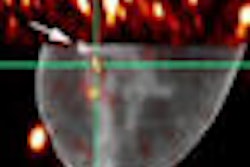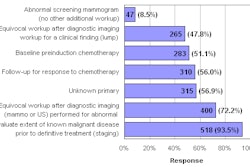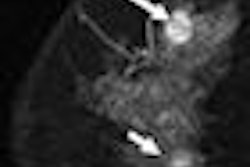Mammograms can be painful -- trying to compress a 3D structure so that a 2D image can be taken of it often leads to discomfort, and equipment developers have been seeking ways to mitigate the problem for years. But a new study to be published in the September edition of Radiology suggests that the fix could be pretty simple: over-the-counter anesthetic gel. And less discomfort could mean more compliance with regular mammography screening.
Colleen Lambertz, a nurse practitioner at St. Luke's Mountain States Tumor Institute in Boise, ID, and Dr. James Maxwell, medical director of the facility's breast care services, recruited 418 women ages 32 to 89 who expected discomfort with screening mammography. Fifty-four of the women claimed they had delayed their mammograms due to concern over this discomfort. "Discomfort" was measured on a scale of 0 to 100, with 0 being none and 100 being the worst pain imaginable. All of the women included in the study expected discomfort of 40 or greater, according to the authors (Radiology, July 22, 2008).
"The expected discomfort scores indicate that the general belief in this motivated population of women was that undergoing mammography hurts," Lambertz and colleagues wrote. "Despite this belief, however, these women scheduled mammography. We do not know how many women do not schedule mammography at all because of this same concern."
The women randomly received placebos or premedication with acetaminophen, ibuprofen, and/or a local anesthetic gel, followed by mammography screening. For those who received the gel, an attending nurse applied it to the women's breasts and chest walls; it was then removed 30-65 minutes before the exam was performed.
The women who received topical application of 4% lidocaine gel reported less breast discomfort during the mammography exam, the authors wrote. Eighty-eight percent of study participants indicated they would definitely get a mammogram the following year, and 10% said they would probably get a mammogram the following year.
Sample sizes and mean unadjusted scores by intervention
|
|||||||||||||||||||||||||||||||||||||||||||||||||||||||||||||||||
| *The doses were 1,000 mg of acetaminophen, 800 mg of ibuprofen, and 1 oz or less of lidocaine gel. Lambertz CK, Johnson CJ, Montgomery PG, et al. Premedication to reduce discomfort during screening mammography. Radiology. 2008;248(3). doi:2482071490. Table 2. Courtesy of the Radiological Society of North America. |
Scores for discomfort during mammography ranged from 0 to 100, with 2.6% of the study subjects reporting no discomfort, 42.3% reporting discomfort scores greater than 40, and 2.9% reporting scores of 90 or higher. The most frequent causes of discomfort were the following:
- Tightness of squeezing (70.4%)
- Pulling on the skin (31%)
- Equipment edges poking into the body (37.5%)
- Coldness of the machine (11.8%)
Why hasn't something like this been tried before? Communication disconnect between patients and their doctors, Lambertz said.
"[Healthcare providers] haven't been listening to the data or to the women," she told AuntMinnie.com. "We've been making a judgment about how much discomfort is acceptable from our perspective, rather than the women's perspective."
One key benefit to discovering that over-the-counter anesthetic gel relieves mammography exam discomfort is that women can feel more in control of the experience, according to Lambertz. Although the gel was applied by a nurse in the study, women could apply it themselves before their exams.
"They can schedule a mammography appointment for a time in their cycle when their breasts are least tender, apply the gel at home, and drive to the appointment knowing they have taken steps toward a positive experience with this potentially lifesaving procedure," she said. "Over-the-counter anesthetic gel is not going to completely eliminate discomfort, but our hope is that it will significantly reduce it."
By Kate Madden Yee
AuntMinnie.com staff writer
August 1, 2008
Related Reading
Cochrane Review studies mammo discomfort, January 25, 2008
Copyright © 2008 AuntMinnie.com




















